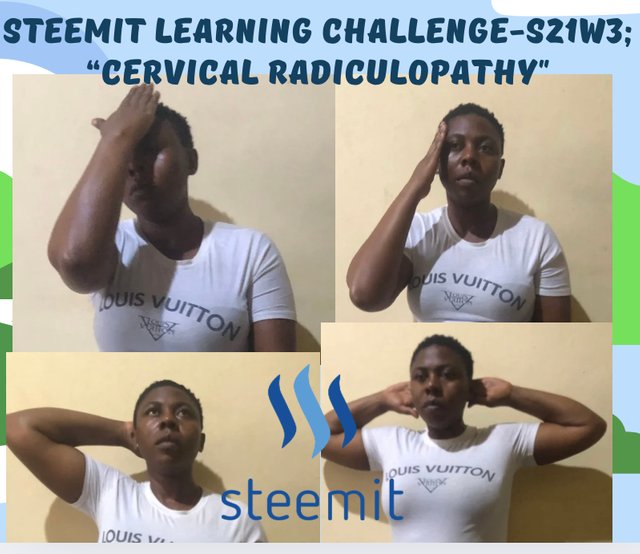Steem greetings from the motherland-Cameroon @everyone on the Steemit ecosystem. It is another week for us to share knowledge about health. As it is often said “…health is wealth”. With this basic health knowledge I acquire from this course, I will share my ideas following the guiding questions as provided by the teacher @ashkhan.

What is Cervical Radiculopathy? |
|---|
After reading through the course, I understood that cervical radiculopathy is a problem experienced when one of your nerves on the neck is inflamed or ruptured. This can lead to radiating pain, numbness on your downer arm, weakness on some specific parts of your body.
Literally, it is usually experienced in conditions of injury or as a result of old age. Dring injury, one can experienced an inflamed nerve which causes changes in the spinal cord. This can caused the injured person to suffer pains around the neck and also upper body pain.
Notwithstanding, the pains people suffering from cervical radiculopathy sometimes depend on the nerve affected. The pain gradually spread to other parts of the body like the chest if not treated on time.
You might be wondering the reasons that can lead you to suffer cervical radiculopathy. Check below for some of the reasons that can probably put you in that condition.
Some Causes for cervical radiculopathy.
There are several causes for cervical radiculopathy but I will explain the main causes as seen below👇.
Spinal Disk ruptured: the middle of our spinal Disk contains a nucleus which is soft and looks like a jelly. When there is a rapture of the spinal disk, the nucleus forces its way out and leads to an inflamed nerve.
Bone Spurs: This happens when we grow older, our joint cartilage grows and add stress to the bones and joints on the spine. This causes extra smaller bones to
grow around the spinal joint. This can lead to compression of the nerves and cause cervical radiculopathy.
Nerve compression: When a nerve in the spinal cord is impeded, it lead to pains beyond our neck to the chest, arm, shoulders and sometimes upper back pain.
Common Symptoms.
- Radiating Pain: as I earlier mention the pain gradually spreads from the neck to chest, arms and upper part of your back.
- Numbness: you are unable to move your arm, neck, fingers or leg easily.
- Headache: You experience headache, especially from the back of your head.
- Weakness: your body muscles become weak and you are unable to lift anything.
Looking at the symptoms, it is not something we should panic because it is curable. For treatment, we need to first get enough rest because our body is not a log of wood, rest is essential. We can also do physical therapy to improve on our bodies in order to stay fit. We can also consult to get medications and in case of any severe pain, surgery can be performed.
How would you diagnose a Cervical Radiculopathy? Any clinical investigation or assessment tests? |
|---|
To diagnose this problem, the doctor needs to ask the patient to describe in detail their symptoms. The doctor also needs to review the patient's medical history to know if its a common family sick.
The examinations on the patient by the doctor includes; checking on their neck, hand, shoulder and arm to see if there is a sensation problem or weakness of muscles. The doctor can also ask the patient to move their neck or arm around and if the patients feel pain moving the neck or arm in a particular direction, then it indicates symptoms of cervical radiculopathy. After all the examinations, some tests are also conducted to confirm if the diagnoses are correct.
Some of the tests to be done are:
- Spurling's Test: The healthcare provider would have to turn your neck and head around in different positions gently exerting some pressure. In this process, the doctor communicates with the patient to be sure which movement of the neck and head causes pain.
- Shoulder Abduction Test: Here the doctor will ask the patient to raise their arms above their head while communicating to know which nerves feels painful during the raising up of the arm.
- Cervical Distraction Test: The health care provider will hold the patient's head and slightly pull it and communicate with the patient to know where the pain is severe or not.
The following clinical investigations are done to ascertain the symptoms.
X-ray:This is to ascertain injury on the spinal disk.
CT Scan:This is done by using machines that scan inside your body structure to ascertain injuries.
MRI: It allows the healthcare provider to see any abnormalities with compressed nerves and a ruptured disk.
EMG: It helps the doctor to ascertain if a nerve is working well without abnormalities. It is used to measure the stimulation of nerves in response to muscles.
Try to practice at least 3 exercises that you have learned from the lesson. Share images, gifs, or videos while practising. |
|---|
The following are the images of the exercises I performed after learning from the course.
 Isometric Neck Flexion
Isometric Neck Flexion  Isometric Cervical Rotation
Isometric Cervical Rotation Isometric Neck Extension
Isometric Neck Extension  Isometric Neck Retraction
Isometric Neck RetractionShare your review after performing these exercises either on yourself, a healthy individual, or a patient. |
|---|
When I performed the Isometric Neck Flexion on myself, it improves the muscles around my neck and I felt more relaxed.
With Isometric Cervical Rotation, I rotate my neck both right and left. I did this repeatedly. This exercise was good for me because I have been suffering from nerve pain aroundmy neck. This exercise helps to strengthen my muscles and I feel better now.
After performing the Isometric Neck Extension, I felt upper back pain may be because of my sitting position for longer hours. After performing the exercise, I felt an improvement with my muscles and relieves me from the pressure exerted on the top of my spinal cord.
The Isometric Neck Retraction exercise I performed helped to strengthen the muscles at the back part of my neck. I performed the exercise while sitting and placing my arms behind my head and pushing my head slightly behind with my chin inside. My head was kept still and I felt a contraction of the muscles at the back of my neck.
In sum, the exercises were the perfect way to strengthen my neck muscles and I feel relieved from the nerves I was suffering from before I performed the exercises. It was a great experience learning the cervical radiculopathy course. I will invite @josepha, @crismenia, @pelon53 and @shiftitamanna to share their ideas.
Thank you for understanding the lesson and sharing your assignment; I hope that you will enjoy this week's lesson and try to implement it in your life if you see any such case.
Observations
Task 1 (2.6/3)
You have shared a good knowledge about cervical radiculopathy, and it's cause, symptoms, treatment, but you have to add the vertebrae involve in cervical radiculopathy & it's second name too. I appreciate your effort.
Task 2 (2.8/3)
In the second question, you tell us about how you have to assess a patient by doing the physical examination, history taking, investigations of patients and specialized tests. You have share good knowledge but the best test for nerve examination is NCS nerve conduction study to assess. Great.
Task 3 (3/4)
You try the isometric cervical rotation, flexion, extension and retraction. But while performing Isometric exercises you have to apply resistance & apply that much force that didn't allow head movement. Try to share gifs if you can't add videos it would better demonstrate. Remember always apply heating pad to relax your muscles before performing these exercises. I appreciate your efforts.
Overall you made a great attempt to answer all the questions. I appreciate your efforts. But next time try to avoid the above written suggestions. Keep learning and try to implement your knowledge to the people suffering from any cervical radiculopathy. Thank you.
Downvoting a post can decrease pending rewards and make it less visible. Common reasons:
Submit
I appreciate your time reading through and giving feedback. I will definitely take all the recommendations seriously.
Downvoting a post can decrease pending rewards and make it less visible. Common reasons:
Submit